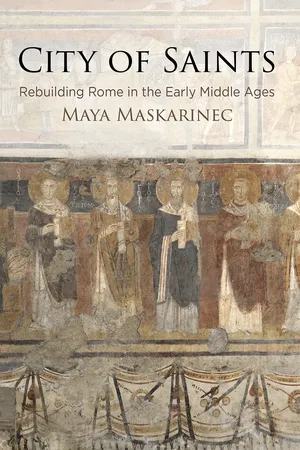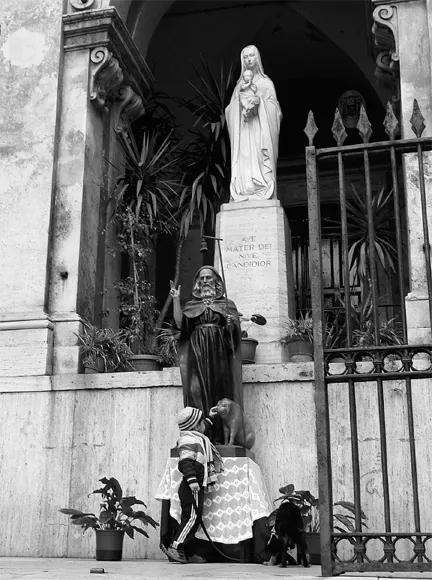![]()
CHAPTER 1
A City of Saints
Sanctity added another dimension to the ecosystem that was Rome. Saints did so by their physical presence in the city and by their stories that reached backward and forward in time. These legends knotted saints to the city and its past, opening up worlds beyond Rome: pagan emperors of bygone centuries, distant cities across the Mediterranean, and the heavens above. This chapter introduces this city of saints with a walk through Rome in the mid-eighth century.1
This walk is largely based on the storehouses of material about Rome that Carolingians collected. In particular I draw on two types of evidence: first, a remarkable ninth-century manuscript produced in the Frankish monastery of Fulda in Hessen (Germany): the Einsiedeln compilation (Codex Einsidlensis 326, ff. 67–97). This manuscript is a compilation of diverse materials, much of it related to the city of Rome. It includes transcriptions of inscriptions from Rome, “itineraries” through the city, statistics about Rome’s wall, a brief liturgical description of mass at the Lateran, and a poetry collection. In Chapter 7 we will return to the Einsiedeln compilation to consider how this manuscript both collapsed the city into a static set of words on the page and magnified the meaning of Rome. In making use of the Einsiedeln compilation to reconstruct early medieval Rome, I am following a long historiographical tradition.2 Second, and less conventionally, my walk makes use of hagiographical texts related to saints found in Rome. These are texts that most often survive today in the versions copied and circulated throughout the Frankish world, particularly at prominent monasteries such as Fulda.
Assisted by archaeological evidence from early medieval Rome, I layer these stories of saints back onto the Roman landscape. My aim is to convey a sense of the city’s rich and multilayered texture of sanctity, showing how Rome’s saints, almost all martyrs of imperial persecutions of bygone centuries, offered a firm foundation of sanctity that was embedded in the fabric of the city’s imperial past. I also point out certain neighborhoods inside the city where the influence of saints from abroad was especially strong. We will revisit these neighborhoods in the chapters that follow.
In layering saints’ stories onto the Roman landscape I draw freely on a wide range of early medieval legends from different sources. Some readers may object to this approach. Accordingly, I should emphasize that my aim is not to reconstruct the viewpoint of one particular observer nor present a comprehensive overview of all potential viewpoints; rather it is to present the sorts of associations that monuments in Rome would have evoked for contemporaries. Such an approach is justified by the fluid relationship between saints, places, and their stories.
The legends surrounding a saint were always in flux. Whether transmitted orally or in writing, stories changed, and in the best of circumstances we can never be sure exactly which versions of a saint’s legend were percolating through the city. What any given individual knew about a saint was, of course, all the more unpredictable. Little is known about the precise practices of saintly commemoration in early medieval Rome. Saints’ legends (martyrs’ passiones or confessors’ vitae) were certainly read aloud on the anniversaries of their feast days, even as a much more diffuse, muddled mix of anecdotes hovered around a saint.3
Take St. Anthony in Rome today. Anthony was a late third- to early fourth-century hermit in the Egyptian desert. His well-known vita, as refracted through twentieth-century literature and film, tends to follow certain recognizable outlines: a renunciation of city life, a struggle with demons, a stark asceticism. It is none of these traits, however, that draws crowds to his statue in the church of S. Eusebio in Rome on the Saturday after his feast day on January 17 (Figure 1). With their dogs, cats, birds, goldfish, and other animals, these pet owners come to have their animals blessed: Anthony’s reputation for protecting animals is clearly evidenced by the pet pig who keeps his statue company. In reconstructing the sanctity of early medieval Rome, we must likewise remain open to such a plurality of stories and associations as refracted in contemporary sources.
As they fluctuated, saints’ stories transformed their surroundings. Because saints had a more immediate impact on the places in which they were situated and the people with whom they interacted on a daily basis, the subsequent chapters focus on changes within specific communities. Yet a saint’s sanctity could also pulse through the city and affect other saints, places, and people. The passio of Tatiana, a Roman martyr, slightly modified, became the passio of the Roman martyr Martina to whom a church was dedicated in the heart of Rome, on the Forum Romanum.4 Adapted yet again, the narrative served to explain the fate of Prisca, another Roman martyr, located high up on the Aventine Hill. Or, in the form of portable trinkets and other paraphernalia, saints themselves moved throughout the city. This chapter provides a glimpse of this larger world of Roman sanctity as background for the more microscopic studies that follow.
Figure 1. Statue of St. Anthony at S. Eusebio. Photograph by author, January 2014.
Let us begin our walk through Rome. Imagine a sunny day in early April 752.5 You are entering the city from the northwest along the ancient via Triumphalis. Just before descending into Rome this road rises onto a slight hill (Monte Mario), where visitors for centuries have admired Rome from above. The undulating Tiber River weaves its way through the landscape. Sharp contours define the city: the nineteen-kilometer wall forms a clear boundary, although by no means a firm limit, to the sprawling metropolis inside.6 The wall itself is a structure that can stand in, as shorthand, for the grandeur that is Rome. A meticulous count might verify that “there are 383 towers, 7,020 crenels, 5 small gates, 116 latrines and 2,066 large windows” in the wall.7
Out of the walls, like tentacles, stretch the cities’ arteries, the sturdy roads—built up from the bedrock—that once connected Rome to its vast Mediterranean empire. In bewildering profusion, centuries of the dead cluster around these roads, clamoring for attention. Smaller steles compete with towering mausolea, each justifying itself with extensive inscriptions. Long names and titles, truncated to single letters, are the norm:
C · DILLIO · A · F · SER · VOCVLAE / TRIB · MILIT · LEG · I · IIII · VIRO · VIARVM · CVRANDAR / Q · PROVINC · PONTI · ET · BITHYNIAE · TRIB · PL · PR / LEG · IN GERMANIA · LEG · XXII · PRIMIGENIAE / HELVIA · T · F · PROCVLA · VXOR · FECIT
With skill we can decode this inscription to learn the genealogy and career of a certain Gaius Dillius Vocula.8 Among the many tombs are other messages too: a stele announces a customs boundary established by decree of Emperor Caesar Marcus Aurelius Antoninus Augustus, assuring merchants that they are obligated to pay their customs duties only once.9
There are merchants on the road, but they don’t give a moment’s pause to these inscriptions. More attentive to the verbal cues are pilgrims. On the road we might meet Fulrad and his lay relative, accompanied by a few servants and a Roman tour guide.10 They are making their way through this pagan monumentality, searching out its Christian treasure: the bones of Roman martyrs. Fulrad (so we may imagine) has brought with him an itinerary that lists the extramural cemeteries around Rome and their saints and is trying to correlate the guide’s information with this document.11
Spacious basilicas with glimmering mosaics are these pilgrims’ most obvious destinations.12 From Monte Mario we are headed to the most spectacular of them all, the Vatican complex, home to Rome’s foremost saint, Peter.13 We must certainly stop to pray near Peter’s relics, but the basilica also has many other attractions to visit.14 Its grand apse mosaic proclaims, “The seat of justice, the house of faith, the hall of chastity: this is what you perceive, what all piety inhabits.”15
The Vatican area around St. Peter’s is a small town unto itself. Here are houses, shops, and fountains. We can purchase trinkets or precious silks imported from the eastern Mediterranean.16 There are monasteries whose monks serve the basilica. Two of these are dedicated to St. Stephen of Jerusalem: as protomartyr, he is always a dependable saint for a Roman monastery.17 There are also scholae, associations of foreigners, united for mutual support and protection and providing assistance to their respective pilgrims or other travelers.18 The Saxons are well established: not long ago Ina, king of Wessex (d. after 726), like his predecessor Cæwalla (d. 689), abdicated his throne and left the rainy British isle to settle in Rome. The Saxon schola is anchored by a church for the Virgin Mary, by far the most popular patron for churches in Rome.19
On the other roads leading into Rome are different, smaller, communities of the living providing for the dead. The monastic communities at these sites vary: some are male, some female, and there are also a few Greek-speaking communities.20 Especially noteworthy are S. Paolo fuori le Mura, home to Peter’s counterpart St. Paul, on the via Ostiensis, and S. Lorenzo fuori le Mura, home to the Roman deacon St. Lawrence, on the via Tiburtina.
Each of these extramural basilicas is shaped by devotion to its patron saint. Entering the compact basilica of S. Agnese on the via Nomentana we are immersed in marble splendor.21 From the main apse, St. Agnes, decked out in rich imperial garb, stares down at us (Plate 1). Two soberly dressed priests stand at either side of her. Shimmering stars hover in the dark blue sky above. On her tomb, below the altar, elegantly carved letters remind us of Agnes’s devoted preservation of her virginity, how she “of her own accord scorned the threats and rage of the savage tyrant,” a resolve that catapulted her to eternal majestic splendor.22 A priest might read out Agnes’s passio for us, grimly detailing how the son of a Roman prefect had fallen madly in love with Agnes on her way home from school one day. He promised her all the wealth in the world if only she would not refuse him. Unimpressed, the little virgin refused and, even when dragged naked through the streets to a brothel, did not lose her trust in Christ.23
On the other side of Rome, along the via Ostiensis, past S. Paolo fuori le Mura, at the monastery Ad Aquas Salvias, we may visit a Greek-speaking community that boasts the head of St. Anastasius. Anastasius—Magundat...




